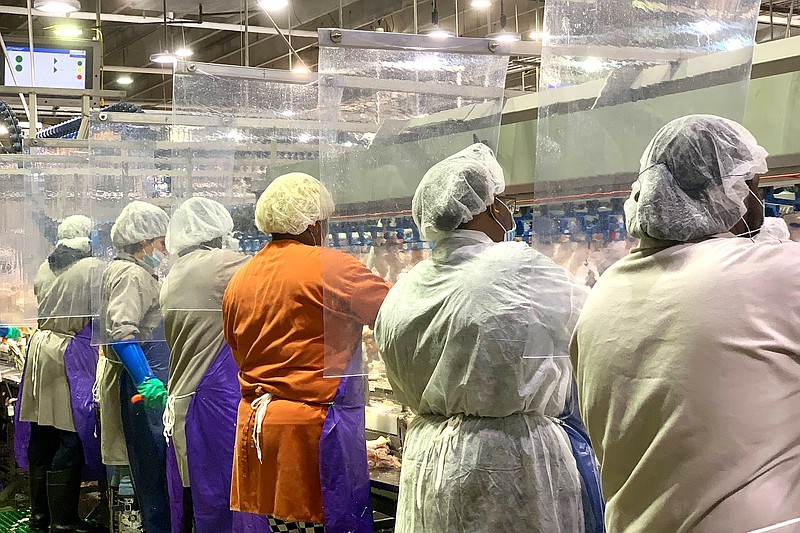OMAHA, Neb. -- Meat production has rebounded from its low point during the coronavirus pandemic when dozens of plants were closed, but experts say consumer prices are likely to remain high and it will take months to work through a backlog of millions of pigs and cattle, creating headaches for producers.
Earlier this week, beef, pork and poultry plants were operating at more than 95% of last year's levels, which was up from about 60% in April at the height of plant closures and slowdowns, according to the U.S. Agriculture Department. That increased production came as companies took steps to protect workers, such as adding plastic partitions between work stations and staggering shifts, that are essential but could slow down the work. The safety measures and bonuses to incentivize workers have also increased costs.
And while worker advocates stress that companies must be vigilant to avoid more coronavirus infections, those steps will likely mean higher prices at grocery stores. Even if plants became more efficient, there is a lag of several weeks between when wholesale prices drop and when consumers start to see the change.
Grocery stores, which absorbed some of the meat price increases this spring, also may not pass along all the price cuts as they try to restore their profit margins.
[CORONAVIRUS: Click here for our complete coverage » arkansasonline.com/coronavirus]
"Don't expect prices to fall in half just because wholesale prices have declined dramatically," said Lee Schulz, a livestock economist at Iowa State University.
Pork prices nationwide were 18.5% higher the week ending May 31 than in the same week a year ago, according to market research firm Nielsen. Beef prices were 23% higher and chicken prices 11%.
President Donald Trump on April 28 ordered government agencies "to ensure that meat and poultry processors continue operations," leading processors to reopen plants, though often with fewer workers and reduced output.
The JBS USA plant in Worthington, the largest pork processor in Minnesota, is now operating at 90% capacity after being closed for more than two weeks in April and May, when nearly half of its 2,000 workers contracted the coronavirus. At least three plant employees have died of the disease caused by the virus.
The Smithfield Foods plant in Sioux Falls, S.D., which endured a large-scale outbreak about a week before the JBS plant, has made "substantial progress" toward normalized production, a spokesman said. He declined to be more specific.
[Gallery not loading above? Click here for more photos » arkansasonline.com/612meat/]
PRODUCTION CHANGES
Besides adopting measures to keep workers healthy, meat processors have also increased production by operating plants more on Saturdays, rather than just weekdays, and by saving time by producing larger cuts of meat, Kansas State University agricultural economist Glynn Tonsor said. That means grocery stores or consumers may have to cut a pork loin down into pork chops instead of that work being done at meat plants, for example.
But to work through the beef and pork backlogs quickly, meat processors may have to find ways to boost production higher than last year's levels, said Will Sawyer, a protein economist at Cobank, an agribusiness bank. Before the pandemic, meatpacking plants had been expected to produce more than they did last year.
Even as production levels climb, it will likely take all summer and maybe into the fall to work through the backlog of more than 1 million cattle and more than 2 million pigs that was created this spring when dozens of plants were closed. That will continue to create problems for farmers and ranchers who are struggling to find space for all those animals and face low prices because of the supply glut.
Mike Drinnin, who owns feedlots in Nebraska, said everyone involved in raising and feeding cattle felt the squeeze when so many beef and pork processing plants were idled, because fewer cattle were being bought by processors. More cattle are remaining in pastures and feedlots longer than normal while ranchers try to slow their growth rate to give themselves more flexibility.
"It's been a long, long, hard haul here since March and all this kind of started," said Drinnin, who serves on the board of the Nebraska Cattlemen trade group. "It's just been quite the struggle for everybody."
'STILL SEEING OUTBREAKS'
As meat plants scale up to full capacity, companies still must ensure that plants don't again become hotbeds of infections, said Mark Lauritsen, director of the food processing and meatpacking division for the United Food and Commercial Workers International union. The union represents roughly 80% of the country's beef and pork workers and 33% of its poultry workers.
"We're still seeing outbreaks," Lauritsen said. "It's a strange virus because it's hard to say where it will pop up next."
Lauritsen said many plants where hundreds of employees became infected have reopened since implementing safety measures. But other plants, like a JBS beef plant in Hyrum, Utah, are just now seeing outbreaks. The plant, where mass testing revealed that 287 employees had covid-19 this week, has had to slow some of its operations, but it remains open.
The union estimates that 13,150 U.S. meatpacking plant workers been infected or exposed to the coronavirus and 57 have died of covid-19, the disease caused by the virus.
Marisol Avelar, who works at a JBS pork plant in Worthington, Minn., said dozens of people are missing every day from her shift on the production line. When she was called back to work last month after the plant temporarily closed, her fears were somewhat assuaged by the safety measures the company had taken. She's still nervous, though, because of talk about infected workers.
"The company has done a lot of work trying to keep everyone safe, but people have continued getting infected," she said.
Information for this article was contributed by Josh Funk and Stephen Groves of The Associated Press and by Adam Belz of the Minneapolis Star Tribune.







